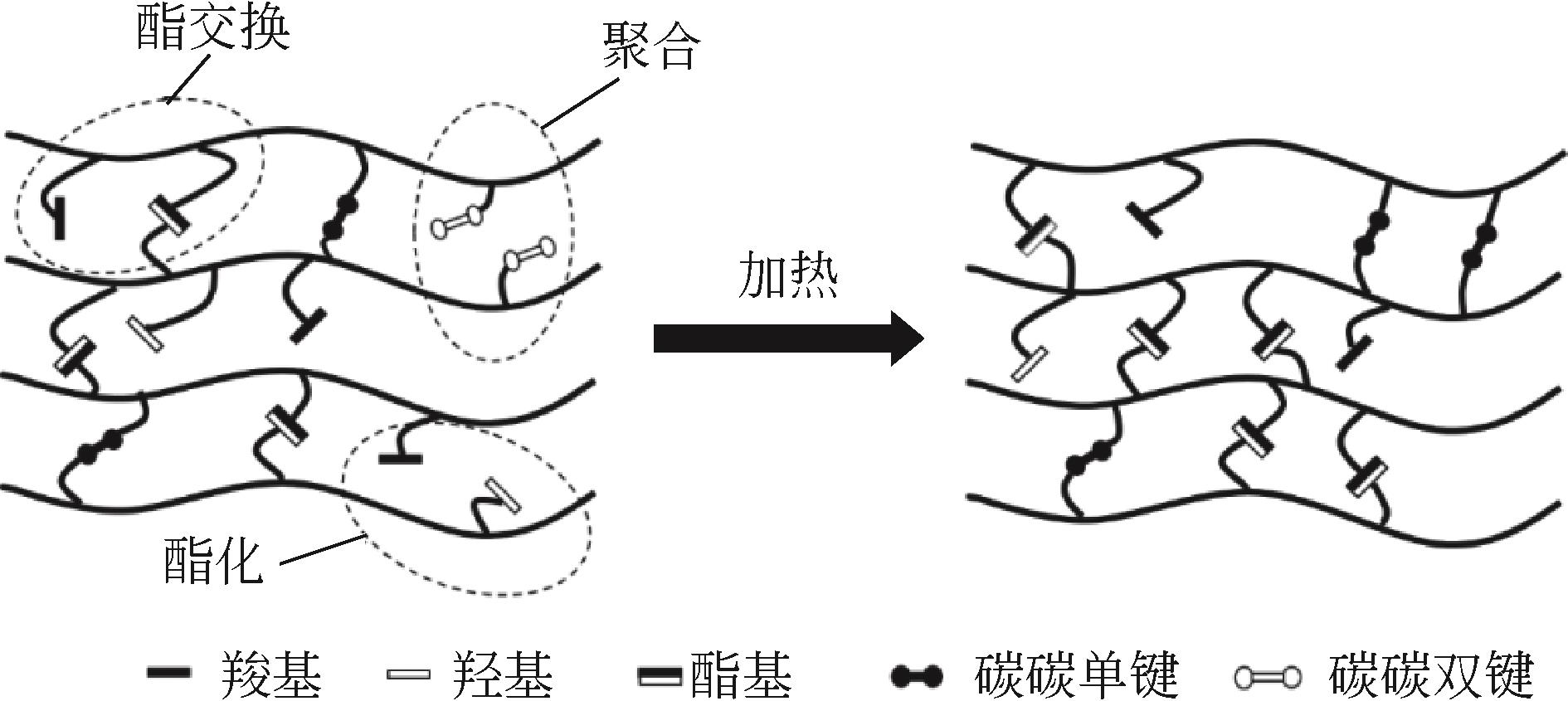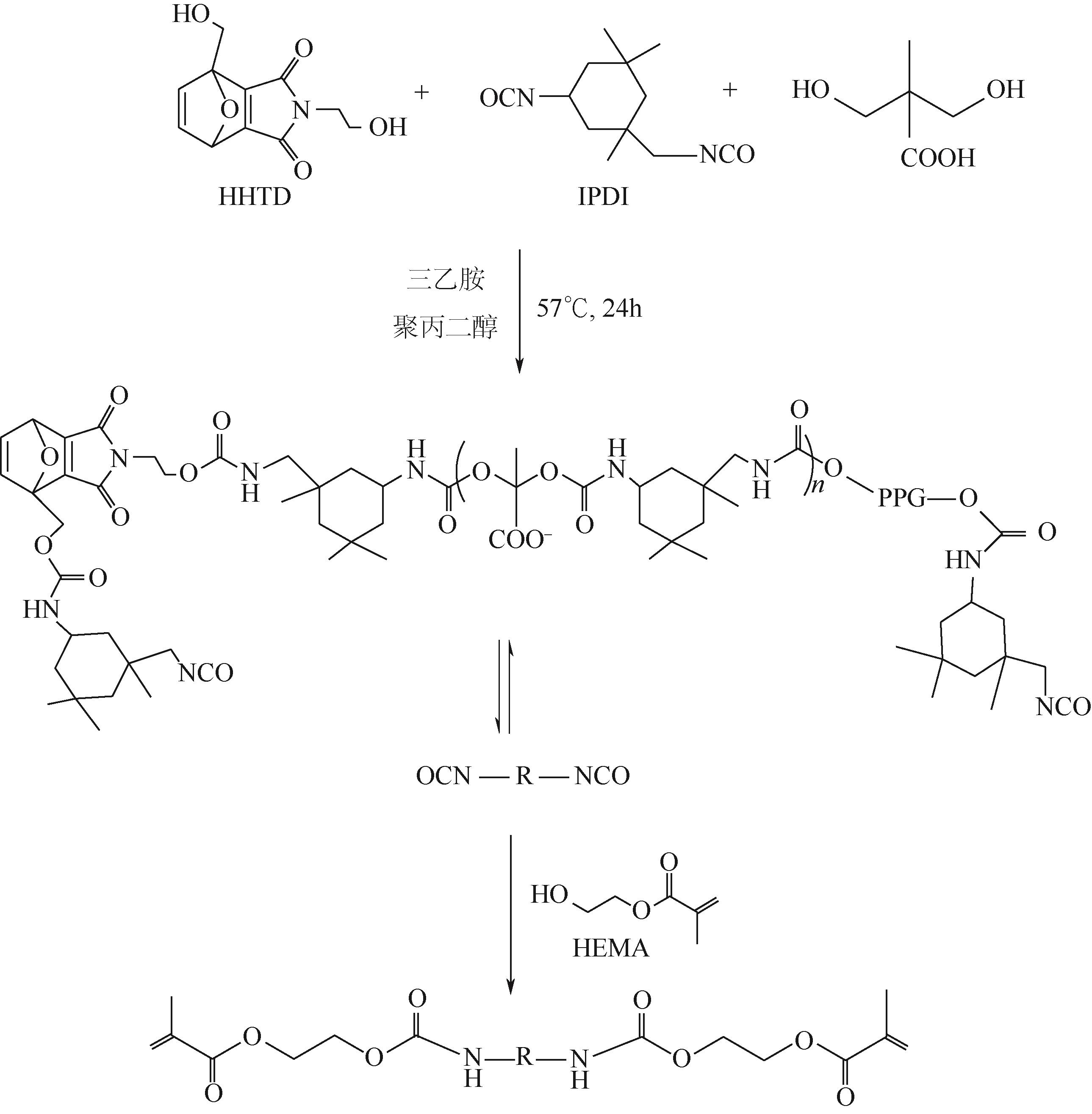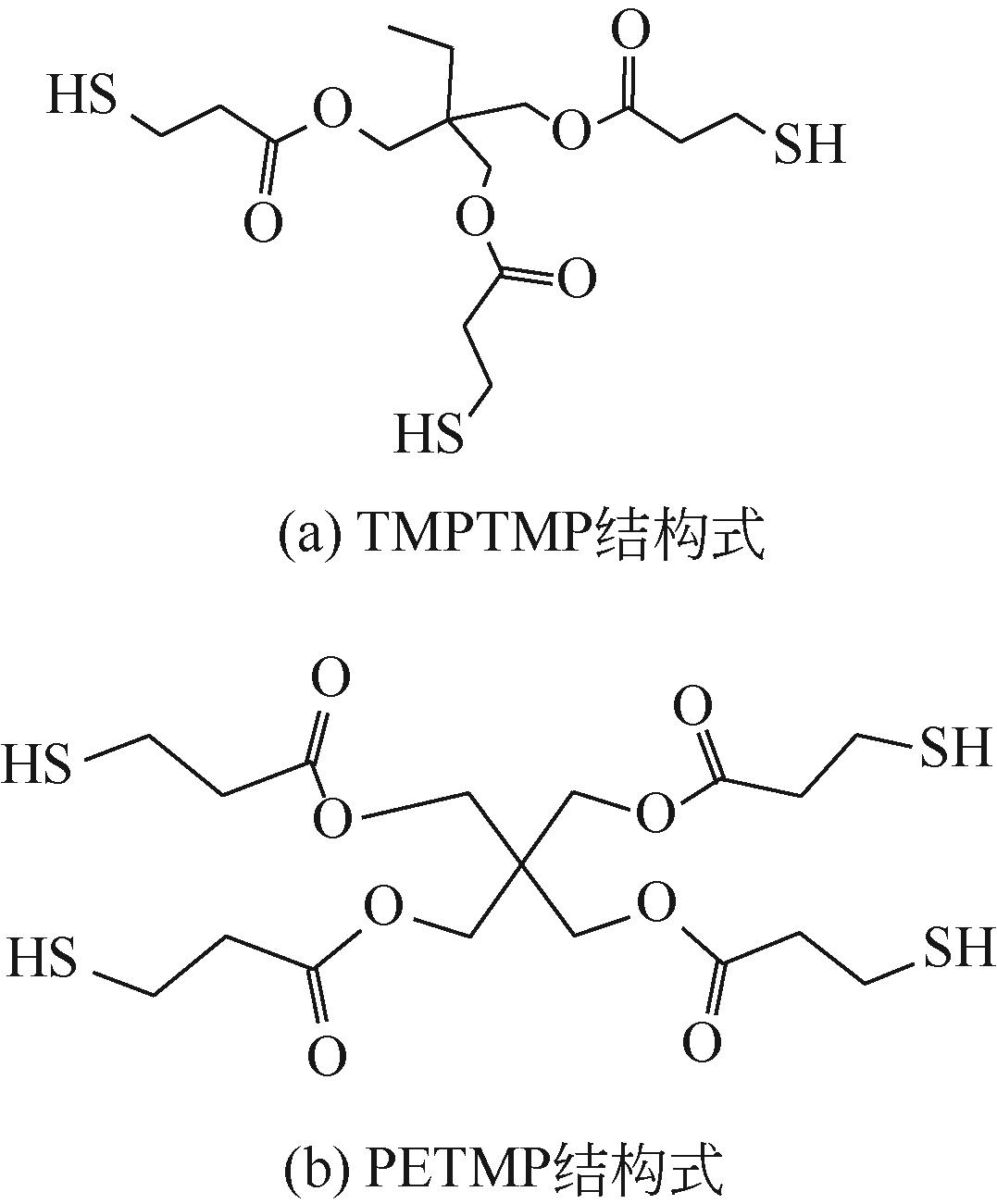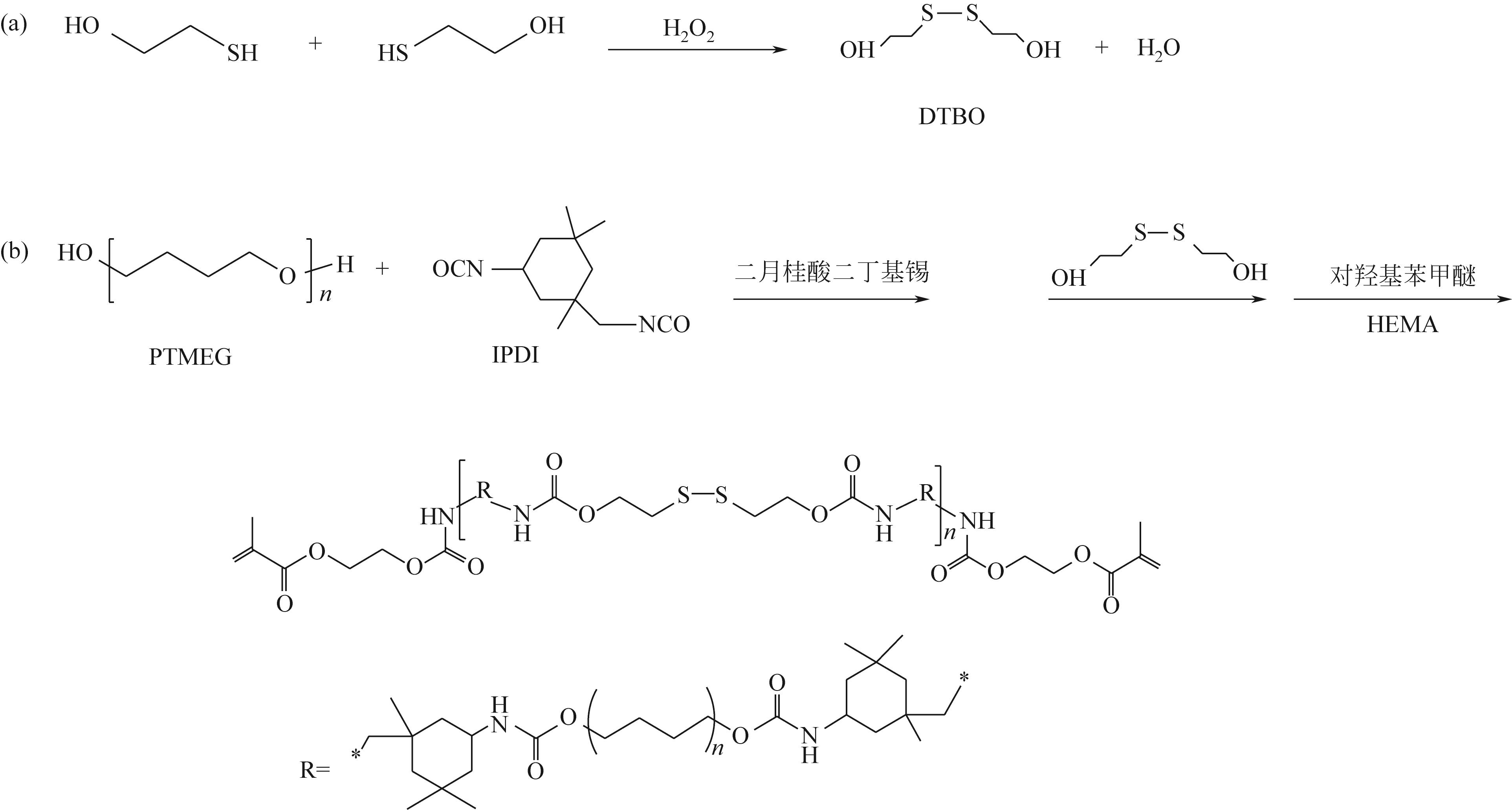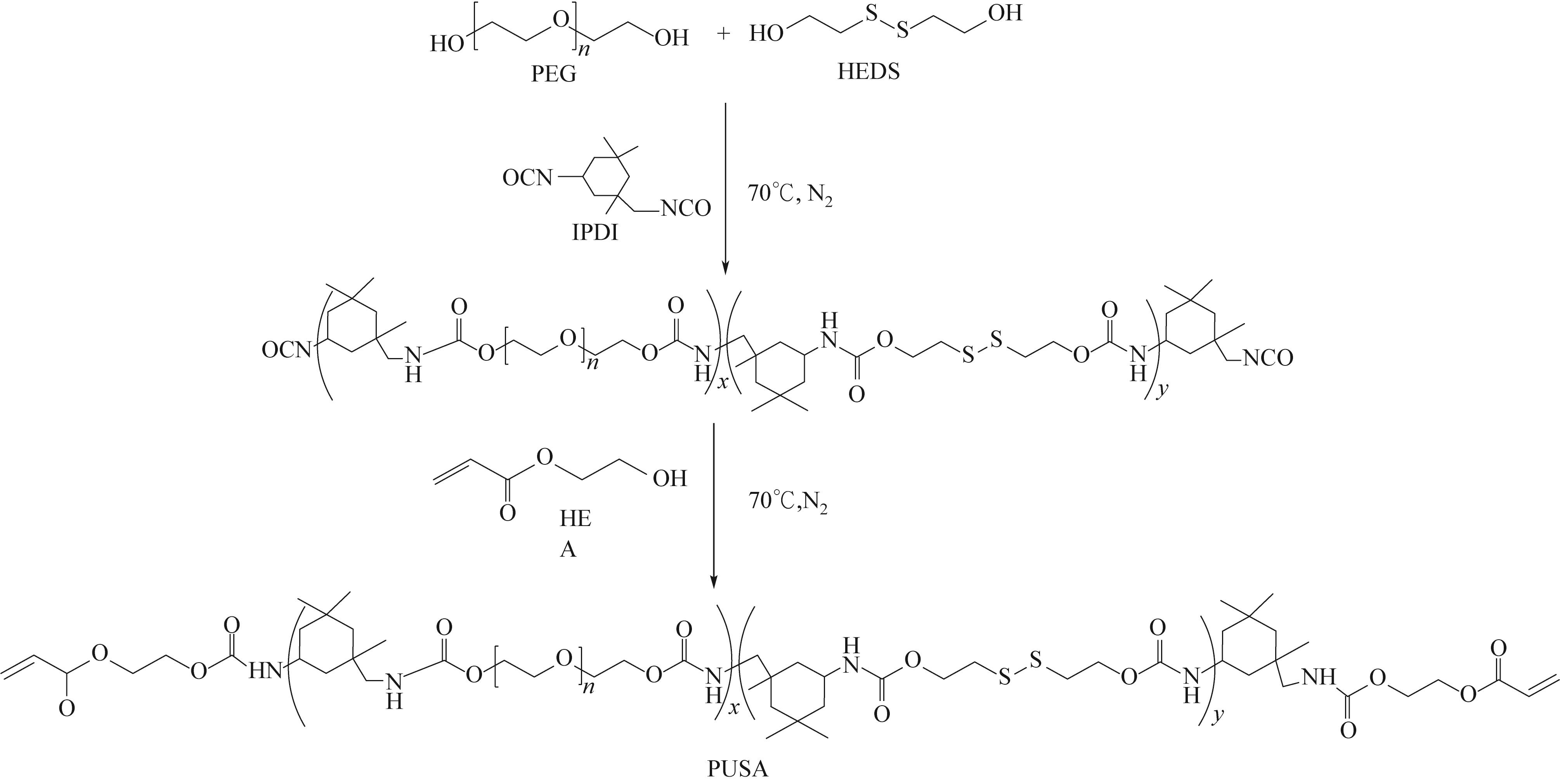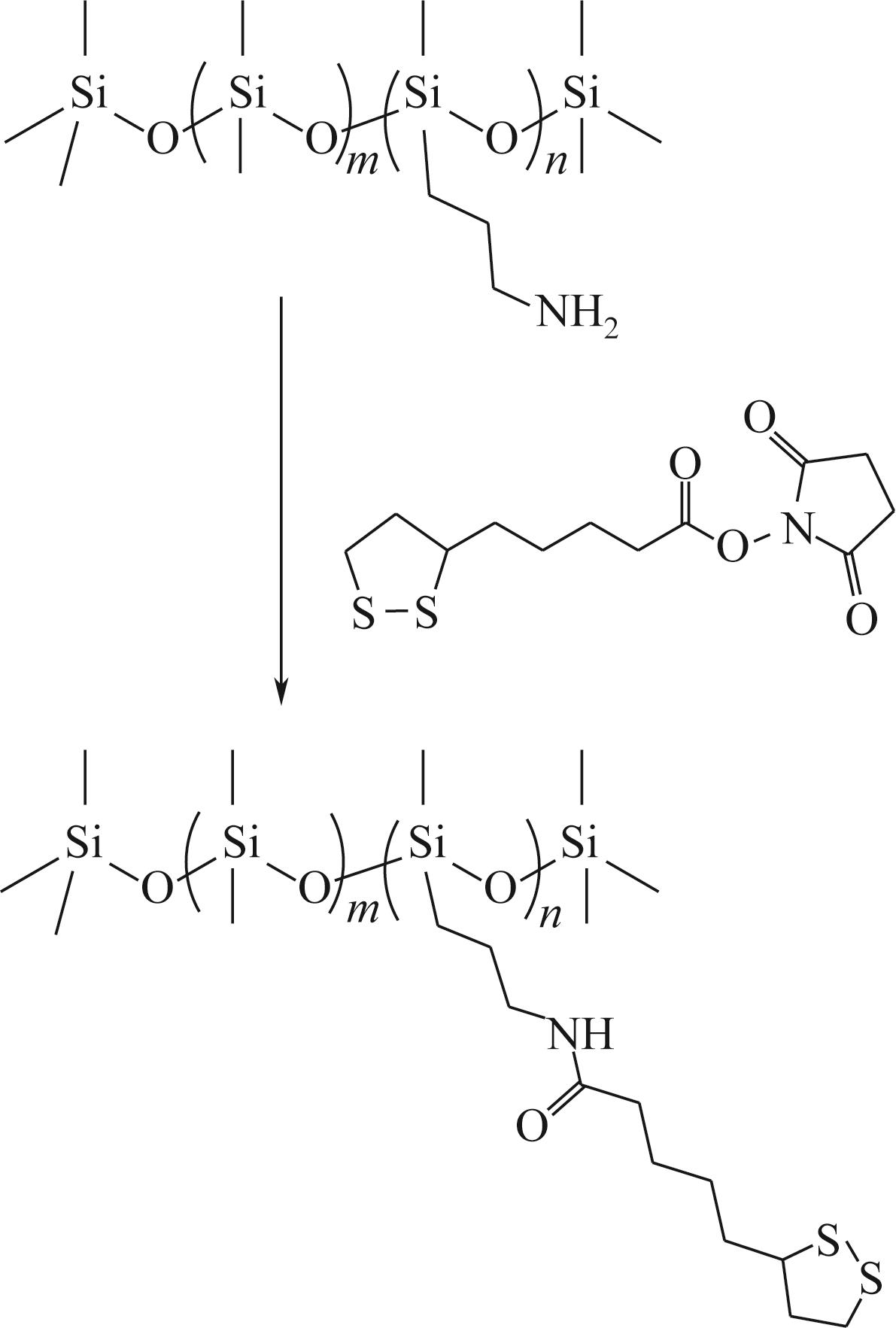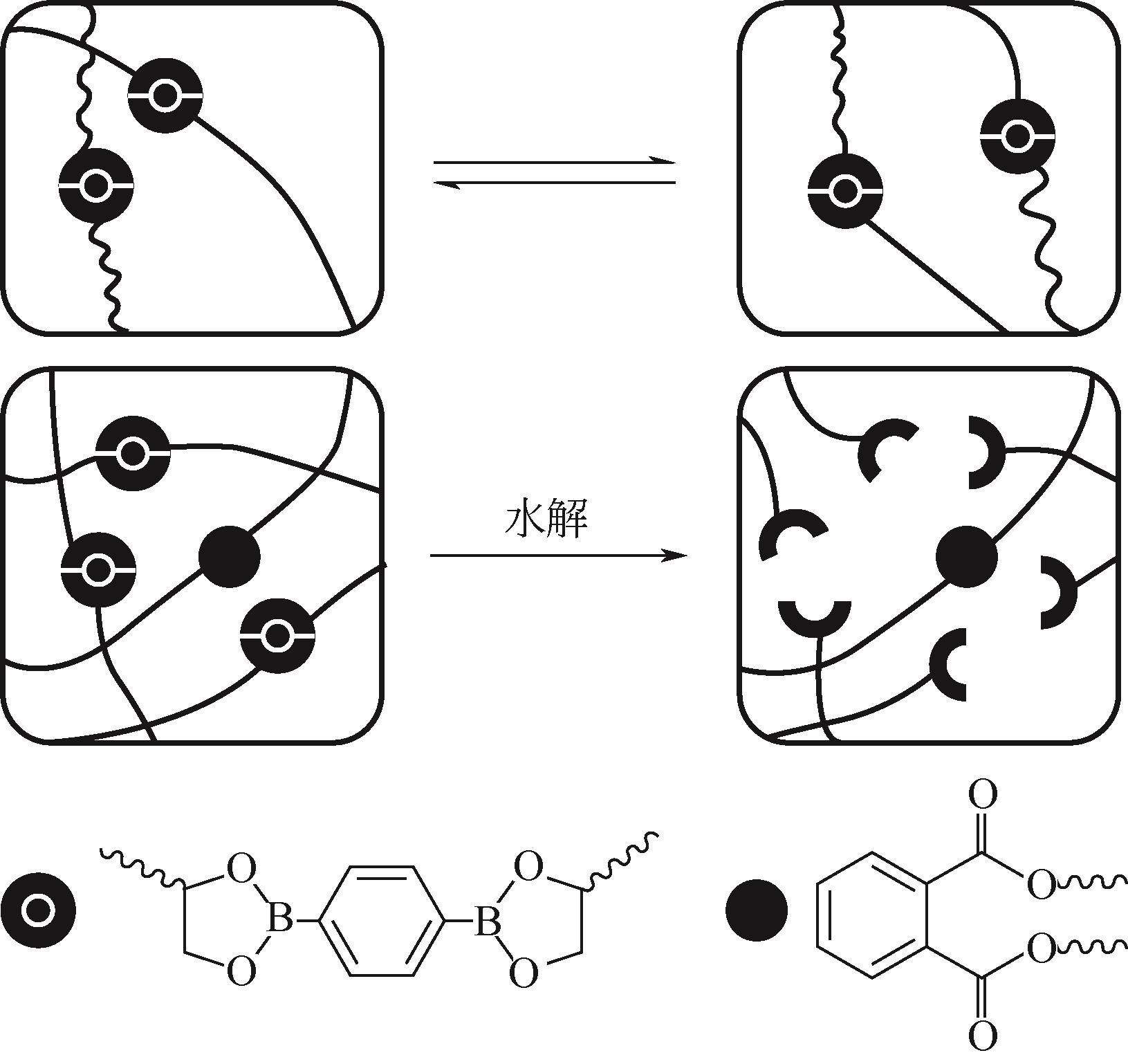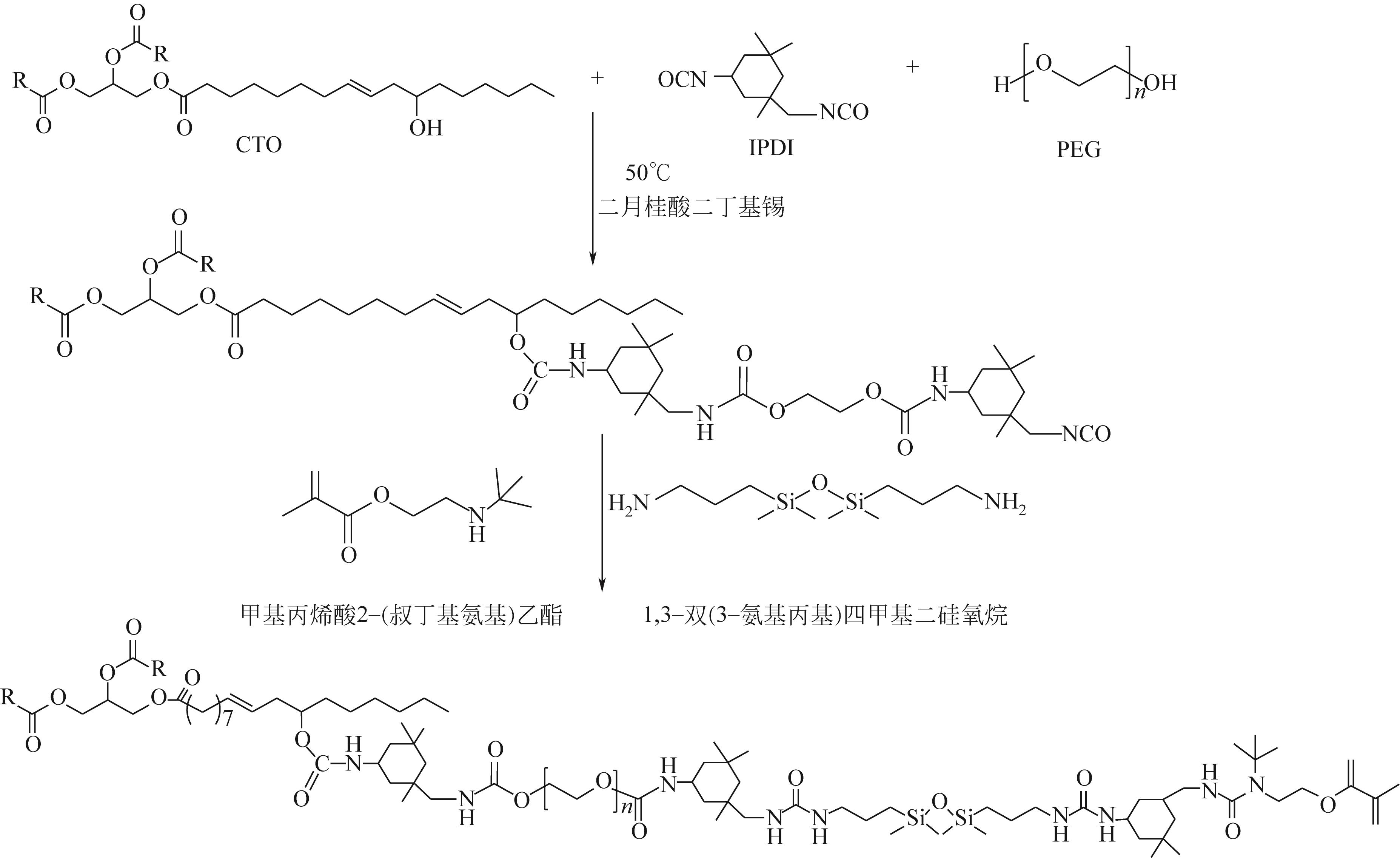Chemical Industry and Engineering Progress ›› 2023, Vol. 42 ›› Issue (7): 3589-3599.DOI: 10.16085/j.issn.1000-6613.2022-1608
• Materials science and technology • Previous Articles Next Articles
Research progress of self-healing photocuring polymeric materials based on dynamic covalent bonds
YU Xixi1( ), ZHANG Jinshuai2, LEI Wen1(
), ZHANG Jinshuai2, LEI Wen1( ), LIU Chengguo2(
), LIU Chengguo2( )
)
- 1.College of Science, Nanjing Forestry University, Nanjing 210037, Jiangsu, China
2.Institute of Chemical, Industry of Forest Products, Chinese Academy of Foresty, Nanjing 210042, Jiangsu, China
-
Received:2022-08-31Revised:2022-10-23Online:2023-08-14Published:2023-07-15 -
Contact:LEI Wen, LIU Chengguo
基于动态共价键自修复的光固化高分子材料研究进展
- 1.南京林业大学理学院, 江苏 南京 210037
2.中国林业科学研究院林产化学工业研究所,江苏 南京 210042
-
通讯作者:雷文,刘承果 -
作者简介:余希希(1999—),女,硕士研究生,研究方向为生物质高分子材料。E-mail:yuxx1012@163.com。 -
基金资助:中国林科院中央级公益性科研院所基本科研业务费专项资金(CAFYBB2020QA005)
CLC Number:
Cite this article
YU Xixi, ZHANG Jinshuai, LEI Wen, LIU Chengguo. Research progress of self-healing photocuring polymeric materials based on dynamic covalent bonds[J]. Chemical Industry and Engineering Progress, 2023, 42(7): 3589-3599.
余希希, 张金帅, 雷文, 刘承果. 基于动态共价键自修复的光固化高分子材料研究进展[J]. 化工进展, 2023, 42(7): 3589-3599.
share this article
Add to citation manager EndNote|Ris|BibTeX
URL: https://hgjz.cip.com.cn/EN/10.16085/j.issn.1000-6613.2022-1608
| 1 | KIM Jin Seung, CHO Bong Sang, KWEON Jeong Ohk, et al. Preparation and properties of UV-curable di-functional sulfur-containing thioacrylate and thiourethane acrylate monomers with high refractive indices[J]. Progress in Organic Coatings, 2014, 77(11): 1695-1700. |
| 2 | BRETTERBAUER Klaus, HOLZMANN Claudia, RUBATSCHER Egon, et al. UV-curable coatings of highly crosslinked trimethylmelamine based acrylates and methacrylates[J]. European Polymer Journal, 2013, 49(12): 4141-4148. |
| 3 | UNNO Noriyuki, SATAKE Shin ichi, TANIGUCHI Jun. Super-resolution technique for nanoimprint mold using elastic UV-curable resin[J]. Microelectronic Engineering, 2013, 110: 167-172. |
| 4 | ZHENG Chao, LIU Guojun, HU Heng. UV-curable antismudge coatings[J]. ACS Applied Materials & Interfaces, 2017, 9(30): 25623-25630. |
| 5 | HAKEIM Osama Abdel, ARAFA Asmaa Ahmed, ZAHRAN Magdy Kandil, et al. Characterisation and application of pigmented UV-curable inkjet inks[J]. Pigment & Resin Technology, 2018, 47(2): 164-172. |
| 6 | SUGITA Hikaru, ITOU Keisuke, ITOU Yoshikazu, et al. Multi-acrylate-based UV-curable dismantlable adhesives[J]. International Journal of Adhesion and Adhesives, 2021, 104: 102758. |
| 7 | AGUIRRESAROBE Robert H, NEVEJANS Sil, RECK Bernd, et al. Healable and self-healing polyurethanes using dynamic chemistry[J]. Progress in Polymer Science, 2021, 114: 101362. |
| 8 | CHANG Kun, JIA Han, GU Shu-Ying. A transparent, highly stretchable, self-healing polyurethane based on disulfide bonds[J]. European Polymer Journal, 2019, 112: 822-831. |
| 9 | Saul UTRERA-BARRIOS, VERDEJO Raquel, LÓPEZ-MANCHADO Miguel A, et al. Evolution of self-healing elastomers, from extrinsic to combined intrinsic mechanisms: A review[J]. Materials Horizons, 2020, 7(11): 2882-2902. |
| 10 | 陈兴幸, 钟倩云, 王淑娟, 等. 动态共价键高分子材料的研究进展[J]. 高分子学报, 2019, 50(5): 469-484. |
| CHEN Xingxing, ZHONG Qianyun, WANG Shujuan, et al. Progress in dynamic covalent polymers[J]. Acta Polymerica Sinica, 2019, 50(5): 469-484. | |
| 11 | LEE Sang Hyub, SHIN Se Ra, LEE Dai Soo. Self-healing of cross-linked PU via dual-dynamic covalent bonds of a Schiff base from cystine and vanillin[J]. Materials & Design, 2019, 172: 107774. |
| 12 | FAN Longfei, RONG Minzhi, ZHANG Mingqiu, et al. Repeated intrinsic self-healing of wider cracks in polymer via dynamic reversible covalent bonding molecularly combined with a two-way shape memory effect[J]. ACS Applied Materials & Interfaces, 2018, 10(44): 38538-38546. |
| 13 | XIANG Hongping, YIN Jingfeng, LIN Guanghong, et al. Photo-crosslinkable, self-healable and reprocessable rubbers[J]. Chemical Engineering Journal, 2019, 358: 878-890. |
| 14 | LIU Maochen, ZHONG Jiang, LI Zijian, et al. A high stiffness and self-healable polyurethane based on disulfide bonds and hydrogen bonding[J]. European Polymer Journal, 2020, 124: 109475. |
| 15 | WANG Shuaipeng, DAI Jinyue, TENG Na, et al. Synthesis of mechanically robust and self-healing UV-curable materials from renewable feedstock[J]. ACS Sustainable Chemistry & Engineering, 2020, 8(45): 16842-16852. |
| 16 | WANG Shuaipeng, TENG Na, DAI Jinyue, et al. Taking advantages of intramolecular hydrogen bonding to prepare mechanically robust and catalyst-free vitrimer[J]. Polymer, 2020, 210: 123004. |
| 17 | ZHANG Biao, KOWSARI Kavin, SERJOUEI Ahmad, et al. Reprocessable thermosets for sustainable three-dimensional printing[J]. Nature Communications, 2018, 9(1): 1831. |
| 18 | LU Chuanwei, WANG Chunpeng, YU Juan, et al. Two-step 3D-printing approach toward sustainable, repairable, fluorescent shape-memory thermosets derived from cellulose and rosin[J]. ChemSusChem, 2020, 13(5): 854. |
| 19 | FENG Xiaming, LI Guoqiang. Versatile phosphate diester-based flame retardant vitrimers via catalyst-free mixed transesterification[J]. ACS Applied Materials & Interfaces, 2020, 12(51): 57486-57496. |
| 20 | ZHANG Jinshuai, HUANG Jia, ZHU Guoqiang, et al. Self-healing, recyclable, and removable UV-curable coatings derived from tung oil and malic acid[J]. Green Chemistry, 2021, 23(16): 5875-5886. |
| 21 | HUANG Jia, ZHANG Jinshuai, ZHU Guoqiang, et al. Self-healing, high-performance, and high-biobased-content UV-curable coatings derived from rubber seed oil and itaconic acid[J]. Progress in Organic Coatings, 2021, 159: 106391-106402. |
| 22 | 黄佳, 张金帅, 朱国强, 等. 基于大豆油和衣康酸的自修复型紫外光固化涂料[J]. 涂料工业, 2021, 51(10): 44-53. |
| HUANG Jia, ZHANG Jinshuai, ZHU Guoqiang, et al. Self-heal UV-curable coatings derived from soybean oil and itaconic acid[J]. Paint & Coatings Industry, 2021, 51(10): 44-53. | |
| 23 | TURKENBURG D H, FISCHER H R. Diels-Alder based, thermo-reversible cross-linked epoxies for use in self-healing composites[J]. Polymer, 2015, 79: 187-194. |
| 24 | LIU Yingling, CHUO Tsai Wei. Self-healing polymers based on thermally reversible Diels-Alder chemistry[J]. Polymer Chemistry, 2013, 4(7): 2194-2205. |
| 25 | KROGSGAARD Marie, BEHRENS Manja A, PEDERSEN Jan Skov, et al. Self-healing mussel-inspired multi-pH-responsive hydrogels[J]. Biomacromolecules, 2013, 14(2): 297-301. |
| 26 | CANADELL Judit, GOOSSENS Han, KLUMPERMAN Bert. Self-healing materials based on disulfide links[J]. Macromolecules, 2011, 44(8): 2536-2541. |
| 27 | LI Qiutong, JIANG Miaojie, WU Gang, et al. Photothermal conversion triggered precisely targeted healing of epoxy resin based on thermoreversible Diels-Alder network and amino-functionalized carbon nanotubes[J]. ACS Applied Materials & Interfaces, 2017, 9(24): 20797-20807. |
| 28 | TURKENBURG Daniel H, DURANT Yvon, FISCHER Hartmut R. Bio-based self-healing coatings based on thermo-reversible Diels-Alder reaction[J]. Progress in Organic Coatings, 2017, 111: 38-46. |
| 29 | KE Xiaoxue, LIANG Hongbo, XIONG Lei, et al. Synthesis, curing process and thermal reversible mechanism of UV curable polyurethane based on Diels-Alder structure[J]. Progress in Organic Coatings, 2016, 100: 63-69. |
| 30 | AIZPURUA June, MARTIN Loli, Mercedes FERNÁNDEZ, et al. Recyclable, remendable and healing polyurethane/acrylic coatings from UV curable waterborne dispersions containing Diels-Alder moieties[J]. Progress in Organic Coatings, 2020, 139: 105460. |
| 31 | WANG Zhengyue, YANG Haitao, FAIRBANKS Benjamin D, et al. Fast self-healing engineered by UV-curable polyurethane contained Diels-Alder structure[J]. Progress in Organic Coatings, 2019, 131: 131-136. |
| 32 | WANG Zhengyue, LIANG Hongbo, YANG Haitao, et al. UV-curable self-healing polyurethane coating based on thiol-ene and Diels-Alder double click reactions[J]. Progress in Organic Coatings, 2019, 137: 105282. |
| 33 | LIU Jingcheng, ZHOU Zhen, SU Xunzheng, et al. Stiff UV-curable self-healing coating based on double reversible networks containing Diels-Alder cross-linking and hydrogen bonds[J]. Progress in Organic Coatings, 2020, 146: 105699. |
| 34 | JIA Han, GU Shuying. A near infrared induced self-healable composite based on disulfide bonds for flexible electronics[J]. Journal of Polymer Research, 2020, 27(10): 1-13. |
| 35 | WAN Ting, CHEN Dajun. Synthesis and properties of self-healing waterborne polyurethanes containing disulfide bonds in the main chain[J]. Journal of Materials Science, 2017, 52(1): 197-207. |
| 36 | MICHAL Brian T, JAYE Colin A, SPENCER Emily J, et al. Inherently photohealable and thermal shape-memory polydisulfide networks[J]. ACS Macro Letters, 2013, 2(8): 694-699. |
| 37 | OTSUKA Hideyuki, NAGANO Shinsuke, KOBASHI Yasuharu, et al. A dynamic covalent polymer driven by disulfidemetathesis under photoirradiation[J]. Chemical Communications, 2010, 46(7): 1150-1152. |
| 38 | HAN Guang, NIE Juyin, ZHANG Huiqi. Facile preparation of recyclable photodeformable azobenzene polymer fibers with chemically crosslinked networks[J]. Polymer Chemistry, 2016, 7(32): 5088-5092. |
| 39 | ZHAO Dongli, LIU Shanshan, WU Yefei, et al. Self-healing UV light-curable resins containing disulfide group: Synthesis and application in UV coatings[J]. Progress in Organic Coatings, 2019, 133: 289-298. |
| 40 | ZHAO Dongli, DU Zhukang, LIU Shanshan, et al. UV light curable self-healing superamphiphobic coatings by photopromoted disulfide exchange reaction[J]. ACS Applied Polymer Materials, 2019, 1(11): 2951-2960. |
| 41 | LI Xinpan, YU Ran, HE Yangyang, et al. Self-healing polyurethane elastomers based on a disulfide bond by digital light processing 3D printing[J]. ACS Macro Letters, 2019, 8(11): 1511-1516. |
| 42 | ZHANG Manwen, TAO Xinglin, YU Ran, et al. Self-healing, mechanically robust, 3D printable ionogel for highly sensitive and long-term reliable ionotronics[J]. Journal of Materials Chemistry A, 2022, 10(22): 12005-12015. |
| 43 | ZHONG Ye, XU Yufang, ANSLYN Eric V. Studies of reversible conjugate additions[J]. European Journal of Organic Chemistry, 2013, 2013(23): 5017-5021. |
| 44 | YU Kunhao, XIN An, DU Haixu, et al. Additive manufacturing of self-healing elastomers[J]. NPG Asia Materials, 2019, 11: 7. |
| 45 | CHENG Kezi, CHORTOS Alex, LEWIS Jennifer A, et al. Photoswitchable covalent adaptive networks based on thiol-ene elastomers[J]. ACS Applied Materials & Interfaces, 2022, 14(3): 4552-4561. |
| 46 | MIAO Jiatao, GE Meiying, WU Yadong, et al. 3D printing of sacrificial thermosetting mold for building near-infrared irradiation induced self-healable 3D smart structures[J]. Chemical Engineering Journal, 2022, 427: 131580. |
| 47 | WANG Zhanhua, GANGARAPU Satesh, ESCORIHUELA Jorge, et al. Dynamic covalent urea bonds and their potential for development of self-healing polymer materials[J]. Journal of Materials Chemistry A, 2019, 7(26): 15933-15943. |
| 48 | ZHANG Qi, SHI Chenyu, QU Dahui, et al. Exploring a naturally tailored small molecule for stretchable, self-healing, and adhesive supramolecular polymers[J]. Science Advances, 2018, 4(7): eaat8192. |
| 49 | ZHANG Qi, DENG Yuanxin, LUO Hongxia, et al. Assembling a natural small molecule into a supramolecular network with high structural order and dynamic functions[J]. Journal of the American Chemical Society, 2019, 141: 12804-12814. |
| 50 | DENG Yuanxin, ZHANG Qi, FERINGA Ben L, et al. Toughening a self-healable supramolecular polymer by ionic cluster-enhanced iron-carboxylate complexes[J]. Angewandte Chemie, 2020, 132(13): 5316-5321. |
| 51 | ZHANG Qi, DENG Yuanxin, SHI Chenyu, et al. Dual closed-loop chemical recycling of synthetic polymers by intrinsically reconfigurable poly(disulfides)[J]. Matter, 2021, 4(4): 1352-1364. |
| 52 | SIEREDZINSKA Bianka, ZHANG Qi, VAN DEN BERG Keimpe J, et al. Photo-crosslinking polymers by dynamic covalent disulfide bonds[J]. Chemical Communications, 2021, 57(77): 9838-9841. |
| 53 | RÖTTGER M, DOMENECH T, VAN DER WEEGEN R, et al. High-performance vitrimers from commodity thermoplastics through dioxaborolane metathesis[J]. Science, 2017, 356(6333): 62-65. |
| 54 | LIU Zhu, XIAO Dingshu, LIU Guocong, et al. Self-healing and reprocessing of transparent UV-cured polysiloxane elastomer[J]. Progress in Organic Coatings, 2021, 159: 106450. |
| 55 | ROBINSON Lindsay L, SELF Jeffrey L, FUSI Alexander D, et al. Chemical and mechanical tunability of 3D-printed dynamic covalent networks based on boronate esters[J]. ACS Macro Letters, 2021, 10(7): 857-863. |
| 56 | LAI Jiancheng, MEI Jinfeng, JIA Xiaoyong, et al. A stiff and healable polymer based on dynamic-covalent boroxine bonds[J]. Advanced Materials, 2016, 28(37): 8277-8282. |
| 57 | PENG Shuqiang, WANG Zian, LIN Jinbin, et al. Tailored and highly stretchable sensor prepared by crosslinking an enhanced 3D printed UV-curable sacrificial mold[J]. Advanced Functional Materials, 2021, 31(10): 2008729. |
| 58 | WANG Sheng, MA Songqi, LI Qiong, et al. Facile preparation of polyimine vitrimers with enhanced creep resistance and thermal and mechanical properties via metal coordination[J]. Macromolecules, 2020, 53(8): 2919-2931. |
| 59 | ZHANG Yanfeng, YING Hanze, HART Kevin R, et al. Malleable and recyclable poly(urea-urethane) thermosets bearing hindered urea bonds[J]. Advanced Materials, 2016, 28(35): 7646-7651. |
| 60 | ZHANG Qiang, WANG Shujuan, RAO Bin, et al. Hindered urea bonds for dynamic polymers: An overview[J]. Reactive and Functional Polymers, 2021, 159: 104807. |
| 61 | JIANG Liang, LEI Yuan, XIAO Yao, et al. Mechanically robust, exceptionally recyclable and shape memory cross-linked network based on reversible dynamic urea bonds[J]. Journal of Materials Chemistry A, 2020, 8(42): 22369-22378. |
| 62 | Sungwoo JUN, KIM Sun Ok, LEE Hee Jin, et al. Transparent, pressure-sensitive, and healable e-skin from a UV-cured polymer comprising dynamic urea bonds[J]. Journal of Materials Chemistry A, 2019, 7(7): 3101-3111. |
| 63 | ZHANG Jinshuai, SHANG Qianqian, HU Yun, et al. Castor-oil-based UV-curable hybrid coatings with self-healing, recyclability, removability, and hydrophobicity[J]. Progress in Organic Coatings, 2022, 165: 106742. |
| 64 | HAMACHI Leslie S, Daniel A RAU, ARRINGTON Clay B, et al. Dissociative carbamate exchange anneals 3D printed acrylates[J]. ACS Applied Materials & Interfaces, 2021, 13(32): 38680-38687. |
| 65 | ZHENG Ning, FANG Zizheng, ZOU Weike, et al. Thermoset shape-memory polyurethane with intrinsic plasticity enabled by transcarbamoylation[J]. Angewandte Chemie International Edition, 2016, 55(38): 11421-11425. |
| 66 | DELEBECQ Etienne, PASCAULT Jean Pierre, BOUTEVIN Bernard, et al. On the versatility of urethane/urea bonds: Reversibility, blocked isocyanate, and non-isocyanate polyurethane[J]. Chemical Reviews, 2013, 113(1): 80-118. |
| [1] | SHI Yongxing, LIN Gang, SUN Xiaohang, JIANG Weigeng, QIAO Dawei, YAN Binhang. Research progress on active sites in Cu-based catalysts for CO2 hydrogenation to methanol [J]. Chemical Industry and Engineering Progress, 2023, 42(S1): 287-298. |
| [2] | ZHAO Wei, ZHAO Deyin, LI Shihan, LIU Hongda, SUN Jin, GUO Yanqiu. Synthesis and application of triazine drag reducing agent for nature gas pipeline [J]. Chemical Industry and Engineering Progress, 2023, 42(S1): 391-399. |
| [3] | WANG Zhengkun, LI Sifang. Green synthesis of gemini surfactant decyne diol [J]. Chemical Industry and Engineering Progress, 2023, 42(S1): 400-410. |
| [4] | LIN Xiaopeng, XIAO Youhua, GUAN Yichen, LU Xiaodong, ZONG Wenjie, FU Shenyuan. Recent progress of flexible electrodes for ion polymer-metal composites (IPMC) [J]. Chemical Industry and Engineering Progress, 2023, 42(9): 4770-4782. |
| [5] | QIAN Sitian, PENG Wenjun, ZHANG Xianming. Comparative analysis of forming cyclic oligomers via PET melt polycondensation and cyclodepolymerization [J]. Chemical Industry and Engineering Progress, 2023, 42(9): 4808-4816. |
| [6] | WANG Shaofan, ZHOU Ying, HAO Kang’an, HUANG Anrong, ZHANG Ruju, WU Chong, ZUO Xiaoling. Self-healing and blue-light hydrogel with pH responsiveness [J]. Chemical Industry and Engineering Progress, 2023, 42(9): 4837-4846. |
| [7] | ZHU Chuanqiang, RU Jinbo, SUN Tingting, XIE Xingwang, LI Changming, GAO Shiqiu. Characteristics of selective non-catalytic reduction of NO x with solid polymer denitration agent [J]. Chemical Industry and Engineering Progress, 2023, 42(9): 4939-4946. |
| [8] | LI Bogeng, LUO Yingwu, LIU Pingwei. Consideration on research content and method of polymer product engineering [J]. Chemical Industry and Engineering Progress, 2023, 42(8): 3905-3909. |
| [9] | WANG Baoying, WANG Huangying, YAN Junying, WANG Yaoming, XU Tongwen. Research progress of polymer inclusion membrane in metal separation and recovery [J]. Chemical Industry and Engineering Progress, 2023, 42(8): 3990-4004. |
| [10] | XIANG Yang, HUANG Xun, WEI Zidong. Recent progresses in the activity and selectivity improvement of electrocatalytic organic synthesis [J]. Chemical Industry and Engineering Progress, 2023, 42(8): 4005-4014. |
| [11] | CHEN Junjun, FEI Chang’en, DUAN Jintang, GU Xueping, FENG Lianfang, ZHANG Cailiang. Research progress on chemical modification of polyether ether ketone for the high bioactivity [J]. Chemical Industry and Engineering Progress, 2023, 42(8): 4015-4028. |
| [12] | YU Jingwen, SONG Luna, LIU Yanchao, LYU Ruidong, WU Mengmeng, FENG Yu, LI Zhong, MI Jie. An indole-bearing hypercrosslinked polymer In-HCP for iodine adsorption from water [J]. Chemical Industry and Engineering Progress, 2023, 42(7): 3674-3683. |
| [13] | WANG Shuaiqi, WANG Congxin, WANG Xuelin, TIAN Zhijian. Solvent-free rapid synthesis of ZSM-12 zeolite [J]. Chemical Industry and Engineering Progress, 2023, 42(7): 3561-3571. |
| [14] | CHEN Xiangli, LI Qianqian, ZHANG Tian, LI Biao, LI Kangkang. Research progress on self-healing oil/water separation membranes [J]. Chemical Industry and Engineering Progress, 2023, 42(7): 3600-3610. |
| [15] | WANG Zhicai, LIU Weiwei, ZHOU Cong, PAN Chunxiu, YAN Honglei, LI Zhanku, YAN Jingchong, REN Shibiao, LEI Zhiping, SHUI Hengfu. Synthesis and performance of a superplasticizer based on coal-based humic acid [J]. Chemical Industry and Engineering Progress, 2023, 42(7): 3634-3642. |
| Viewed | ||||||
|
Full text |
|
|||||
|
Abstract |
|
|||||
